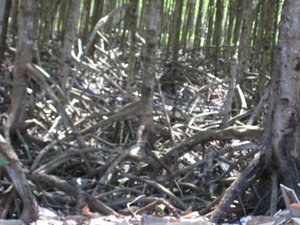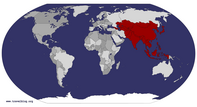Advertisement
Published: October 6th 2008

 Roots
Roots
Mangrove roots, from Monkey Island. I didn't take my camera with me for the mud crawl or mangrove biodiversity counting. I think that title fairly well sums up our last excursion to Can Gio. It was great, overall, but in the moment, well... it was really muddy; there were lots of mangroves; and often we don't know what's going on at all, so cats living under water encapsulated that feeling.
Can Gio really was amazing, though, like most everything else I've seen or done here in Viet Nam. The first day we were there, we climbed around a bunch of mangroves that had been planted around 30 years ago, after the "American War." There's a debate going on whether or not the park should continue to manage the mangrove forest, by thinning it out and selling the wood for charcoal and lumber or not. We looked at two different parts of the park where the mangroves hadn't been thinned at all since being planted, and at another part where they had been thinned 50%. We counted the number of trees in 100 square meters, took the diameter, and height. I really enjoyed climbing around the mangrove roots. They're so much stronger than they look- all spindle-y. To get to the mangroves, we walked on this narrow, muddy path beside a

 Sea of Mangroves
Sea of Mangroves
From the tower outside the Commune headquarters. It was a really shaky metal tower, 30 meters tall. Pretty fun. canal, which is where the cats lived under the water. It wasn't a communication/translation problem, because the guide from Can Gio made sure we understood he meant cats (like tigers) that lived under water (pointing to the water), but they were not like fish. I'll let you puzzle on that riddle for a while.
The next full day, we we did a "transect walk," which is a huge misnomer. It was more of a transect crawl/wade, through, in some parts, waist-deep mud, mangrove roots, plants, crabs, and snakes, barefoot. It was quite an experience. My clothes are filthy, as I figured the best method for me was to distribute my weight and sort of slide and glide along on my hands and knees. I felt like a baby mudskipper. The whole reason we were doing this was to take soil samples and look at the progression of mangrove and other plant species starting by the river and going to the road, for about 300 meters. We stopped every 50 meters to get samples, take notes, and listen to our prof talk. After we got into the mangroves, I thought the mud would improve some, and it did, at first.

 Monkeys!
Monkeys!
Monkeys from Monkey IslandBut that was deceiving. Once in the trees, there were lots more roots to scrape your feet and while not all of it was waist-deep, there were parts that were past the knee. So, in the moment, I admit, wasn't really enjoying it. But, after the fact, how many people can say they've done that? And it wasn't really that bad.
After sort of washing off with rainwater back at the Commune headquarters in Can Gio, we took a boat ride to this man's house out in the park. Can Gio is a Biosphere Reserve, so people are allowed to live within the park, help manage the mangroves, and use the aquatic resources, like fish, snakes, and crabs. So this man was raising shrimp (tiger shrimp and local banana shrimp) in salt water/mangrove ponds. I jumped in one with my clothes on to help wash the mud off, and I turned out suprisingly much more clean than I had been before. The water was a very pleasant temperature. Then we had lunch and discussed the pros and cons of allowing people to exploit natural resources within the park.
The man who provided us lunch isn't actually a local from Can Gio. He also has a house in Ho Chi Minh City, and multiple other sources of income. (These are my thoughts on all this): He doesn't really need to exploit the mangroves or aquatic resources in Can Gio like the poor of Tram Chim do. It's an interesting juxtaposition. Since Can Gio is a biosphere, it's allowable, but it's a process to apply, and not too many familes are part of it. And it seems that perhaps the ones who are, don't actually need to be, since they're like the guy who gave us lunch, who has plenty of money. The man was also against conservation, even for his children. He'd rather make money now, and save that money for his children, and not save the natural resources. Conservation biology is much more complicated than I had originally thought, when learning about it at Austin College. I think in Tram Chim, they should open the park up for fishing for the most poor, but in Can Gio, the rich are benefitting, and since all the trees are replants, they're not really "natural" especially when they're managed and thinned for charcoal and timber. People are allowed to get the aquatic resources, like crabs and shrimp, but people still want to thin the mangroves and make money. I think it should be conserved, and people can still be allowed to get a sustainable number of aquatic resources. Then it might start to resemble a "natural" forest/ecosystem in 50 or more years. It's interesting, and I don't really know. Those are just my unorganized thoughts on the matter. This trip is really thought-provoking for sure.
That night we had mudskipper for dinner. They actually can be eaten. They're a bit muddy tasting, even though they were fried. There are lots of game meat restaurants around parks, according to our prof, and this was one of them. It also begs the question whether or not they were exploited from inside the park, which can't be proved either way. More food for thought 😊
On our way back from Can Gio (a six hour bus ride), we stopped at Monkey Island, which isn't really an island. But there were lots of monkeys and crocodiles. The monkeys were friendly and aggressive at the same time, since the park officials fed them food to get them close to the tourists. But, once they were too big, the park rangers would scare them away from the food and the people, with sling shots. It's a very different sort of eco-tourism. We saw one monkey jump up onto a guy and steal his coke in a bag. (the best way to get a drink to go- in a bag). The crocodiles were all in a large-ish area with mangroves and water and being fed. There was a high density of them, though.
Monkey Island did solve the cat that lives under water mystery, though. They had a museum, and some poorly taxidermied animals, including one that looked strikingly like a strange looking cat.... so, drum roll please..... the cat that lives under the water is an OTTER!
And last night for dinner, I made dinner for my family. It was quite an improvization. I made some of my family's all time favorites- gazpacho, shrimp quesadillas, and peanut butter brownies, all of which can be made on the stove, as ovens are not common in Viet Nam houses. The gazpacho probably turned out the best, and had most all the right ingredients. It wasn't a pretty red color, the way it should have been, though, since I used a green pepper, and didn't peel the cucumbers.... but it tasted good. My family's never had cold soup before, and the taste was really different for them. But they were all good sports and had at least two bowls of it. I ate the most though, since they just throw left overs away, and don't have leftovers. But, I liked it, and I think they liked it pretty well.... cooks out there- my homestay mom said she thought apple would be a good addition....?
Then I made shrimp quesadillas. That took a little more thought. They don't have tortillas here, so I ended up getting this rice paper that was actually kind of sweet. But, it went well enough, because Vietnamese are all about sweet and salty, yin and yang in their food. They also only have European type cheeses, so the best I could get to Monterey Jack was fake cheddar from La Vache Qui Rire, and sandwich cheese, which I tore up into little pieces... They luckily have tomatos, shrimp, and cilantro, so that was all good. But, these rice paper tortillas do not hold up as well as regular torillas, and we ended up serving them in a bowl, all crumpled together. Needless to say, my presentation of food was not very beautiful. But, again, I think it tasted pretty good. I wasn't totally pleased, but it wasn't a complete failure, either.
For dessert, I made these peanut butter chocolate refridgerated brownies... they required the most flexibility. There's no powdered sugar, no graham crackers, and no semi-sweet chocolate chips (or any chocolate chips for that matter). So, I got these "sweet crispy crackers" that turned out okay, used some flour and a little sugar, since they' don't like things too sweet, and a Symphony bar of milk chocolate, which does NOT melt like chocolate chips.... So, it was basically peanut butter and crackers which were more salty than in the US, dotted with hunks of chocolate.... But, all things considered, dessert wasn't too disasterous. Plus, they thought it was cute and funny I wanted to cook for them. And I think they were really glad I didn't make something more American, like hamburgers. 😊
I hope this wasn't too boring and technical. It's basically just a lot of my thoughts. To make a link to the last blog, Karaoke was lots of fun, the biotech students asked us interesting questions, and we had an awesome totally vegetarian dinner at this really nice restaurant. We had lots of kinds of mushrooms in a hot pot and my favorite- fried pumpkin flowers. Delicious! and with much better presentation than my little Tex-Mex-American-Huston family meal hehe.
Advertisement
Tot: 0.074s; Tpl: 0.012s; cc: 11; qc: 28; dbt: 0.0271s; 1; m:domysql w:travelblog (10.17.0.13); sld: 1;
; mem: 1.1mb









meg
non-member comment
cute pun!
food for thought...teehee